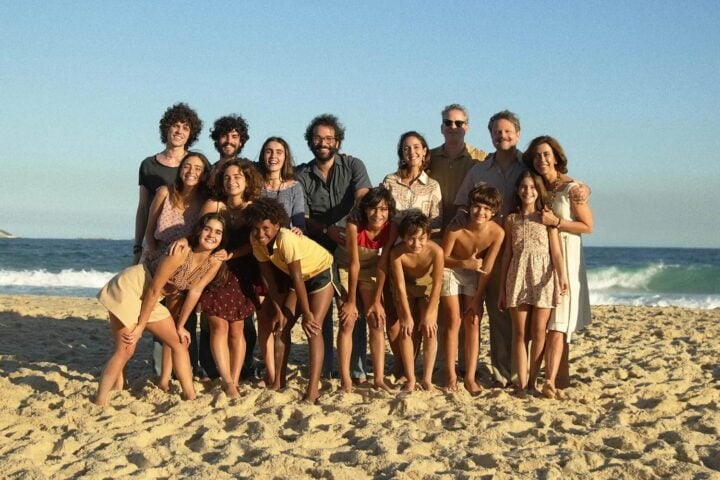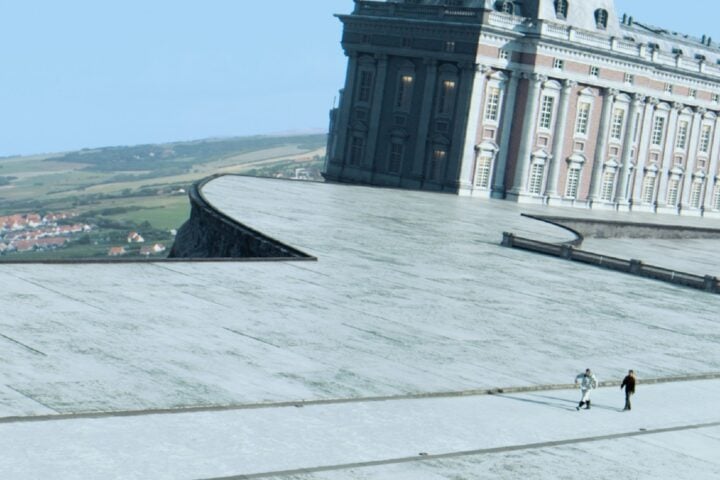No sound so definitively evokes Jewish culture in the popular imagination as that of klezmer. With perceptible roots in Eastern Europe and a purely secular function, it’s a musical form that provides a direct link to centuries-old folk traditions that have all but vanished since the Holocaust. The Klezmer Project, the debut feature of Argentinian filmmakers Leandro Koch and Paloma Schachmann, combines documentary footage with a metatextual narrative to explore the remnants of Yiddish culture in small villages throughout the historical region of Bessarabia—the nexus of Moldova, Romania, and Ukraine, where the musical language of the Jews who lived there is kept alive by those who knew them.
In the early part of the 20th century, Hungarian composer Béla Bartók transcribed thousands of folk melodies across Eastern Europe, and in its own modest way, The Klezmer Project is guided by a similar spirit of preservation. Among other things, the film is a genuine work of ethnomusicology, incorporating textual references from Susana Skura and Bob Cohen (who’s also interviewed) and capturing some astonishing field recordings of folk musicians.
Early on in their journey, the filmmakers track down Ivan Popovych, the only surviving member of the Técsői Banda, a Ukrainian band that had played a range of ethnic music throughout Bessarabia. The footage of Popovych at home, casually bowing out a melody on the fiddle while his wife sings along, contains a raw power beyond anything heard in The Klezmer Project’s few concert sequences, virtuosic though those performances are.
But the documentary’s strength also lies in the diversity of its musical offerings: a modern-traditional klezmer lineup (Banda Segundo Mundo); a rousing recorder/piano duet (between César Lerner and Marcelo Moguilevsky); a single violin played by a Romanian mail carrier over his daughter’s rhythmic guitar strumming; a Yiddish song sung by a man crossing from Ukraine into Romania to attend synagogue. If the entirety of The Klezmer Project had consisted only of extended recording sessions, it would be thoroughly satisfying.
Koch and Schachmann, who appear in the film as lightly fictionalized versions of themselves, frame their cultural investigation within an invented love story. “Leandro” is a wedding videographer who, smitten with “Paloma,” a klezmer clarinetist, fibs about making a documentary on klezmer and follows her to Europe, ostensibly to document a tour by the Lerner Moguilevsky Dúo. Leandro enlists his friend, filmmaker Lukas Valenta Rinner, as an executive producer, and together they successfully pitch the project for German television.
Lukas, being beholden to the project’s financiers, repeatedly expresses frustration that they aren’t finding any klezmer bands on their Eastern European jaunt. It’s almost something of a running joke—a klezmer movie without klezmer—but as Bob Cohen explains later, the traces of Jewish culture are found in the negative impressions left by its absence. Indeed, attuned listeners will pick up on the shared roots of the folk music heard in the film.
Of course, while Leandro falls in love with Paloma, he’s also learning to appreciate his own heritage, toward which he had seemed indifferent, even hostile, at the beginning (Lukas jokingly calls him an antisemite at one point). But the details of the love story proper are a little sketchy and underdeveloped, with its emotional and thematic content filled in by a Yiddish folktale (read by Perla Sneh in voiceover) that runs in parallel to it. Though intrusive, this overlay of voice and subtitled text is also one of the only sources of spoken Yiddish in the film, making it a worthy addition in theory, if unwieldy in practice.
As with a traditional documentary, The Klezmer Project is affected by forces outside the filmmakers’ control; its preproduction dates back to before the Covid pandemic, and political conditions around the film have shifted. Koch and Schachmann entertain the thesis that the creation of the state of Israel, which emphasized Hebrew and marginalized Yiddish as a way of casting off European identity, was the death blow for Yiddish culture. A quote from Skura’s writings early on describes this as an assassination. This thread in the film’s discourse would have been provocative five years ago, but resonates differently amid the ongoing war in Gaza.
Likewise, the film’s images of unspoiled Ukrainian landscapes were taken in 2021, less than a year before the Russian invasion. As the filmmakers explain in the press notes, the border town they stayed in is now a transit center for those fleeing the country. Enhanced by hindsight, this elegiac film takes on yet another tragic dimension that Koch and Schachmann could never have anticipated. As they say in Yiddish, der mentsch trakht un got lakht: man plans, God laughs.
Since 2001, we've brought you uncompromising, candid takes on the world of film, music, television, video games, theater, and more. Independently owned and operated publications like Slant have been hit hard in recent years, but we’re committed to keeping our content free and accessible—meaning no paywalls or fees.
If you like what we do, please consider subscribing to our Patreon or making a donation.



